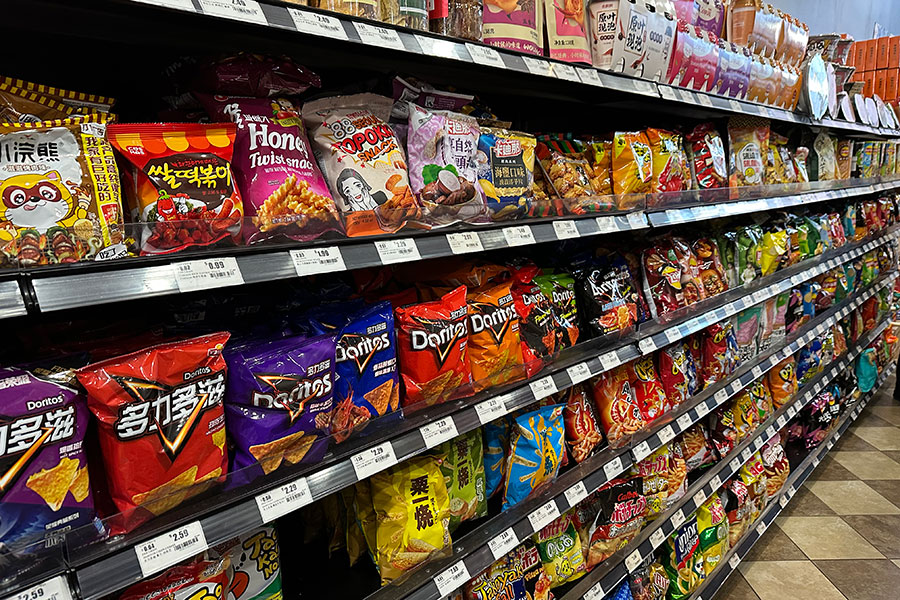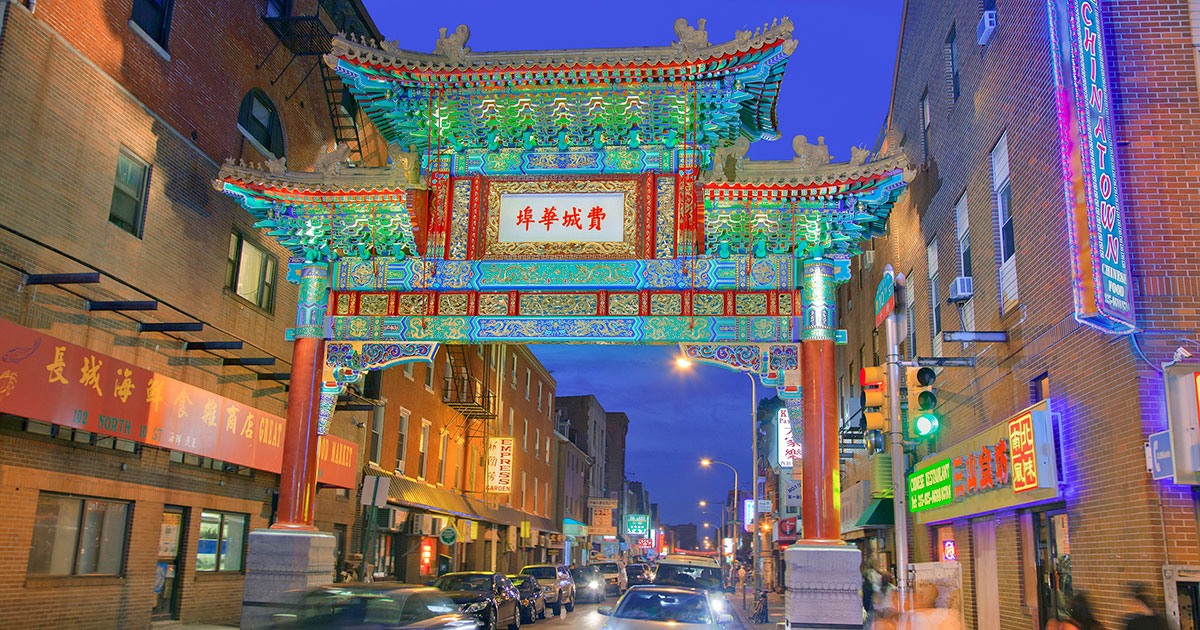Stocking up for Lunar New Year? Here’s where to go for the freshest fish, hard-to-find fruits and vegetables, and every Asian snack you can think of.
Chinatown Friendship Arch / Photograph by Hope Daluisio for Visit Philadelphia
For the uninitiated, the grocery stores in Chinatown can seem tricky to navigate, only penetrable by the most fluent speakers of Mandarin or Cantonese. But anyone who has so much as peeked at the open produce boxes outside them knows that these shops are wellsprings of deeply discounted kitchen staples and covetable specialty snacks. And while the convenience of their location is challenged by markets like Hung Vuong in East Passyunk and New Spring Garden in Northern Liberties, food shopping here is essentially a local foodie’s rite of passage. Forget lot parking and wide aisles. Where else can you compare persimmon prices among three stores within a block of each other, then pick up a bubble tea and takeout mee goreng afterward?
So, whether you’re taking the El or scouring for street parking, get your butt to Chinatown with plenty of reusable bags in hand, maybe download a translation app, and ball out on veggies, seafood, and snacks that you may or may not have even heard of before.
Where to Go for Groceries in Chinatown
Heng Fa Food Market
This local chain (also called Hung Vuong Food Market) has locations from Berwyn to Cherry Hill and is known for its diverse selection of Chinese and Vietnamese products. It’s not surprising, then, that the Chinatown location is one of the two most popular grocers in the neighborhood. Take a note from seasoned shoppers and bring your own wheelie carts to navigate the tight aisles. And don’t forget to walk down to the basement for other goods like condiments and noodles.
What to Buy: The fresh produce is front and center, and you can’t beat the variety and pricing, from $2 papayas to specialty veggies like snake beans and celtuce. Look to the butcher and refrigerated meat sections for everyday cuts such as pork belly and beef short ribs, as well as specialty proteins like black chicken, pork trotters, and various offal. It’s a great source for thinly shaved hot pot meat, too.
Tip: The most popular meat in China and multiple nearby countries is pork, so it’s not surprising that Heng Fa carries an especially wide range of its parts. The bones are a particular boon for homemade stock makers. Leg bones, neck bones, and trotters are all good picks, but for the richest, most flavorful result, pick up two or three types for a good balance of marrow and collagen. 130 North 10th Street.

The selection of fish at Asianfresh / Photograph by Ethan Pan
Asianfresh Food Market
Merely half a block away from Heng Fa, Asianfresh is Chinatown’s other big grocery store and offers a similar (but not exactly the same) scope of groceries. Similar to Heng Fa’s basement section, the second floor is where you’ll find a majority of Asianfresh’s dry and frozen goods. Besides the crowded checkout line, where a staff member is often rushing you to the next available cashier, the atmosphere here is generally a little less chaotic than Heng Fa.
What to Buy: One of Asianfresh’s strengths is its seafood section with ample live tanks that aren’t too crowded. The live tanks are also where you’re likely to find some English labels (score!), although the section of whole fish on ice, which is by and large a boon, doesn’t have labels in English or Chinese and only lists the prices. Sort through the produce by the entrance, then head upstairs for ample candies and frozen dumplings and buns.
Tip: Buying fresh seafood can be nerve-wracking, even without language barriers. Asianfresh is fairly friendly to English speakers, but if you’re unsure, pull up the English and Chinese names of the fish you’re looking for ahead of time. When picking your catch, look for clear eyes and firm flesh that doesn’t smell fishy. Don’t be afraid to point to the specific fish you want, either. 142 North 10th Street.
Chung May Food Market
Walking into Chung May, it’s clear that the market intends to service the local Chinese population first and foremost. You won’t be met with a bevy of fresh produce, but you’ll find long rows of dried Chinese medicinal herbs instead. Here are the pros: It’s quieter here, owing to the lack of music and fewer shoppers, and there is an impressive selection of dry goods that’s especially worth perusing if you need to shop in bulk.
What to Buy: Giant bulk bags of dried shiitake mushrooms populate an entire row of the store and are way more cost-effective than the little packages in Western supermarkets. This is also a great spot to pick up teas (both traditional and herbal), dry noodles, Cantonese-style sausages, and various sauces and condiments from across the Asian continent.
Tip: When buying shiitakes, generally opt for the type with large white cracks spanning the brown caps. They tend to be more fragrant, and their thicker flesh has a more satisfying texture when cooked. You’ll also get more bang for your buck if you opt for mushrooms with shorter, thinner stems or ones that are entirely removed since they’re too woody for consumption. 1017 Race Street.

The snack aisle at S Mart / Photograph by Ethan Pan
S Mart
At S Mart, the S stands for snacks. You won’t find any fresh produce or proteins here, but you will find the most comprehensive selection of Asian-imported chips, crackers, candies, ramen, and canned beverages in the city. Whether you’re shopping for edible gifts, stocking up for future munchies, or setting out a party spread of sweet and salty nibbles, this petite store has you covered.
What to Buy: S Mart stocks every flavor of Samyang’s iconic buldak (hot chicken) ramen—and at the cheapest prices that we could find, to boot. Also look for the guoba (scorched rice) crackers, a full line of flavored mochi, muscat grape gummy candies, and cans of light and creamy Yeshu coconut drink.
Tip: There’s a $10 card minimum, so bring cash or stock up. 222-224 North 10th Street.
Where to go for Baked Goods and Desserts
The grocery stores in Chinatown tend to lack options for pastries, desserts, and the like, but luckily, there are plenty of businesses nearby to make up for it.
After you’re done shopping at the grocery stores above, jazz up your haul with goodies from one (or more) of Chinatown’s bakeshops. They specialize in not-too-sweet cakes, pastries, and breads that work just as easily for breakfast as dessert. Place a quick to-go order of baked char siu pork buns, egg tarts, and sesame balls at Bread Top House (1041 Race Street), or dine in at Mayflower Bakery (1008 Race Street) and savor a coffee-scented Swiss roll with a warm milk tea.
Festive Chinese desserts often require hard-to-find ingredients and clunky tools such as a steamer setup, making them difficult to prepare at home. Heung Fa Chun Sweet House (112 North 10th Street) lets you skip that step of your holiday meal. Pick up nian gao (steamed sticky rice cake) for the Lunar New Year, zongzi (sticky rice dumplings wrapped in bamboo leaves) for the Dragon Boat Festival, and doufuhua (silken tofu that can be prepared sweet or savory) for any time.

